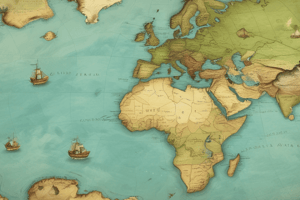Podcast
Questions and Answers
During the late 1950s to the late 1960s, what was the main focus of human geography?
During the late 1950s to the late 1960s, what was the main focus of human geography?
- Application of computers and statistical tools (correct)
- Encyclopaedic description
- Exploration and discovery
- Regional analysis
What characterized the period of the late 1970s in human geography?
What characterized the period of the late 1970s in human geography?
- Use of laws of physics in geography
- Emergence of humanistic, radical, and behavioural schools (correct)
- Dependence on encyclopaedic descriptions
- Increased interest in exploration and discovery
Which approach in human geography focused on identifying the uniqueness of different regions?
Which approach in human geography focused on identifying the uniqueness of different regions?
- Areal differentiation (correct)
- Exploration and description
- Regional analysis
- Spacial organization
What was the main discontentment that led to the emergence of the humanistic, radical, and behavioural schools in the 1970s?
What was the main discontentment that led to the emergence of the humanistic, radical, and behavioural schools in the 1970s?
What was the key objective of the later Colonial period in human geography?
What was the key objective of the later Colonial period in human geography?
Which period in human geography was marked by the application of laws of physics to map and analyze human phenomena?
Which period in human geography was marked by the application of laws of physics to map and analyze human phenomena?
What was questioned in the 1990s Post-modernism in geography?
What was questioned in the 1990s Post-modernism in geography?
Which sub-field of human geography is related to anthropology?
Which sub-field of human geography is related to anthropology?
What is the sub-field of human geography that deals with the study of welfare economics?
What is the sub-field of human geography that deals with the study of welfare economics?
Which discipline is not directly related to human geography?
Which discipline is not directly related to human geography?
What is the sub-field of human geography that deals with the study of rural areas?
What is the sub-field of human geography that deals with the study of rural areas?
Which sub-field of human geography is related to business studies?
Which sub-field of human geography is related to business studies?
Flashcards are hidden until you start studying
Study Notes
Broader Stages of Human Geography
- Exploration and description characterized the early colonial period, driven by imperial and trade interests, with geographers providing encyclopaedic descriptions of new areas.
Early Colonial Period
- Regional analysis was a key aspect of this period, with elaborate descriptions of all aspects of a region, aiming to understand the parts as part of a whole (the earth).
1930s to Inter-War Period
- Areal differentiation became the focus, aiming to identify the uniqueness of each region and understand how and why it differed from others.
Late 1950s to Late 1960s
- Spatial organisation marked this period, characterized by the use of computers and sophisticated statistical tools, applying laws of physics to human phenomena, and seeking mappable patterns for different human activities (the quantitative revolution).
1970s
- Discontent with the quantitative revolution led to the emergence of humanistic, radical, and behavioural schools of thought, making human geography more relevant to socio-political reality.
1990s
- Post-modernism in geography questioned grand generalisations and the applicability of universal theories to explain human conditions, emphasizing the importance of understanding each local context in its own right.
Human Geography and Sister Disciplines of Social Sciences
Sub-fields and Interfaces
- Social Geography interfaces with Sociology
- Behavioural Geography interfaces with Psychology
- Geography of Social Well-being interfaces with Welfare Economics
- Cultural Geography interfaces with Anthropology
- Gender Geography interfaces with Sociology, Anthropology, and Women’s Studies
- Historical Geography interfaces with History
- Medical Geography interfaces with Epidemiology
- Urban Geography interfaces with Urban Studies and Planning
- Political Geography interfaces with Political Science and Electoral Geography (Psephology)
- Military Geography interfaces with Military Science
- Population Geography interfaces with Demography
- Settlement Geography interfaces with Urban/Rural Planning
- Economic Geography interfaces with Economics
- Geography of Resources interfaces with Resource Economics
- Geography of Agriculture interfaces with Agricultural Sciences
- Geography of Industries interfaces with Industrial Economics
- Geography of Marketing interfaces with Business Studies, Economics, and Commerce
- Geography of Tourism interfaces with Tourism and Travel Management
- Geography of International Trade interfaces with International Trade
Studying That Suits You
Use AI to generate personalized quizzes and flashcards to suit your learning preferences.




